French gardens have a spirit and a presence all their own. I have walked and wandered in dozens of French jardins over the years – in the ‘biggies’ such as Versailles, Fontainebleau, Vaux-le-Vicomte, Chantilly, St. Germain-en-Laye, Sceaux, St. Cloud, and the Tuileries, and in smaller ones cradling manor houses and petits châteaux in various corners of France. And the regal yet neighborhoody jardins du Luxembourg in Paris is still my favorite for a daily jog in Paris.
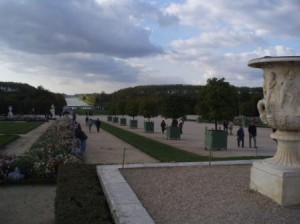
The magnificent gardens of Versailles
To this day, entering a French garden takes my breath away. It is a visceral as well as an emotional experience. There is a moment of awe and surprise – surprise at the arresting beauty…and also surprise that human beings have mastered a natural space so eloquently – followed by a deep sense of plaisir (pleasure), paix (peace) and bien-être (well-being).
I’ve often asked myself what it is that makes French gardens so captivating. At first glance, one could say it’s quality of the light and climate that makes these green spaces worlds unto their own. But truth be told, the pleasure of French gardens has much to do with their flawless grasp of space, symmetry and harmony. The French perfected these aspects of French garden design in the 17th and 18th centuries when the royals and other nobility laid out spectacular formal gardens around their châteaux. The French use of perspective and order provides a superb foundation for additional decorative elements that, once they’re there, seem to have always been destined for that particular place in nature.
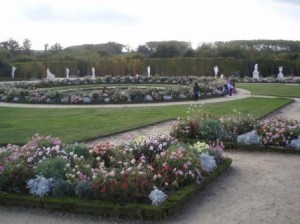
Many of these principles of French garden design have survived and flourished over time resulting in a ‘language of French gardens’ that is alive and well. Before you next visit a French jardin, you might want to familiarize yourself with these garden terms and then see how they play out in various garden locations in France:
Allée – A straight path, or alley, often lined with trimmed trees for an architectural effect. Allées typically accentuate the lines of perspective radiating from the house or château and leading off into the horizon. This is one of my most favorite parts of French gardens.
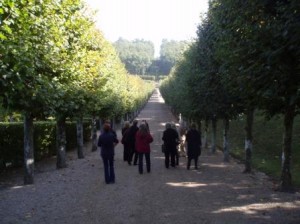
Our French Affaires’ travel group exploring the Gardens of Villandry last fall
Banc – French gardens provide places to stop and savor the moment. Benches, or bancs, are often the focal point of ‘outdoor garden rooms’ and offer a peaceful resting spot amidst nature.
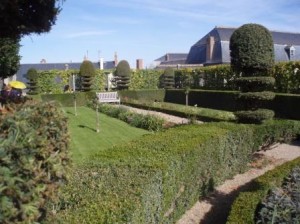
Bassin – Water is essential in French garden design. A bassin (pond) acts as a mirror to the sky, adding a shimmering effect to surrounding greenery and reflecting the nearby château.
Bosquet – A small ‘wood’ or group of trees usually set some distance from the house or main building.
Broderie – Meaning ‘embroidery’ in French, broderie indicates a curlicue pattern within a parterre often created out of boxwood or yew bushes.
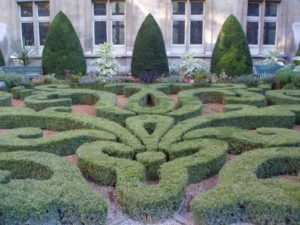
Escalier – Stairs lead from various garden levels to another. Some French garden designers also create ‘stairs’ of water out of canals and fountains to add further depth to the garden experience.
Orangerie – Since the time of Louis XIV, French formal gardens have included exotic plants from various locales, in particular orange trees. To help them survive the winter, they were placed in an orangerie, or serre (greenhouse), and kept warm until spring.
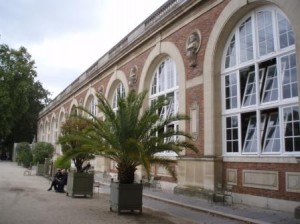
The orangerie at the Luxembourg Gardens in Paris
Parterre – A square or rectangular planting bed containing ornamental designs of flowers, bushes, green lawn, and/or gravel. Elaborate parterres often include scrollwork, various geometric shapes or fanciful designs to enchant the eye.
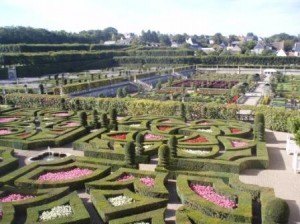
A view over the various parterres at the Gardens of Villandry
Pelouse – French gardens include simple manicured green lawns juxtaposed against more decorative elements for a balanced and calming effect. Note that it is often interdit (forbidden) to walk on tender French lawns as it might spoil their beauty – a small sign at ground level indicates this.
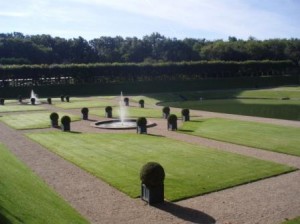
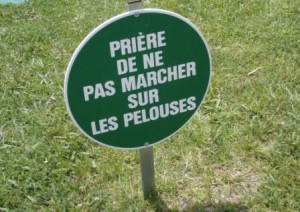
Potager – A French vegetable garden is known as a ‘potager.’ This is different from a jardin, jardin de fleurs or jardin d’agrément (ornamental garden) where flowers, trees and other plants take center stage.
Sculpture – French gardens are adorned with pieces of sculpture, often with roots in mythology, to entertain the eye and/or mark important places or pathways within the garden. This bird is certainly entertained as he sits on the mythological god’s head.
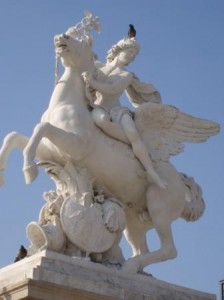
Terrasse – Terraces are incorporated into classical French gardens as places to take in the beauties of the entire garden, especially the parterres, at one glance. They are also perfect for taking photos…
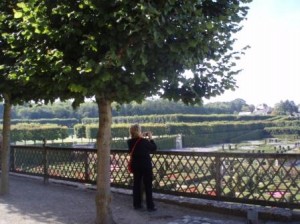
Topiaire – The French love to combine their artistic talents with their desire for order by pruning yew trees into fantastic shapes. As a result, their topiary achievements are second to none in the gardening world. All French formal gardens contain topiaries of some sort, inspiring awe and wonder at how these creations come into being – and at how they are maintained!
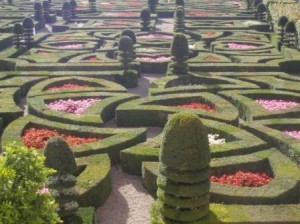
French Take-Out ~ La France à emporter
A final French garden expression of note is ‘jardin remarquable,’ or Noteworthy Garden. The French have awarded this distinction to 361 special French gardens located throughout France. They are well worth a visit – our French Affaires’ trip to the "Great Chateaux & Gardens of the Loire Valley & Paris" features several jardins remarquables, including Villandry, Rivau, Valmer, Versailles among others.
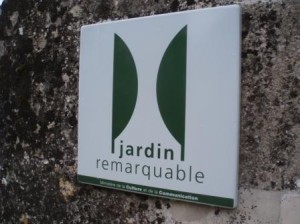
There are a few spots still open on this remarkable journey – don’t miss this personal and inside view of garden delights, memorable châteaux, gourmet meals with wine and much more. Click here for trip dates, details and photos. Come join us at the height of French garden beauty in June!